The total number of COVID cases in Michigan increased to 32,000 (Chart 1), which was equivalent to 320 cases per 100,000 people (Chart 2) on April 20. The number of new cases reported on April 20 for the State of Michigan—576–is the lowest that has been reported since March 26, according to the Michigan Department of Health and Human Services.
Of the total COVID cases, the City of Detroit had 7,736 cases, Oakland County had 6,178 cases, Wayne County (excluding Detroit) had 6,176 cases and Macomb County had 4,425 cases (Chart 3). In the early weeks of April Wayne County (excluding Detroit) regularly had a fewer total number of COVID cases than Oakland County. However, the April 20 data shows that now Wayne County only has two less cases than Oakland County. This highlights a decreasing rate of spread in Oakland County and an increasing rate of spread in Wayne County (excluding Detroit). The number of confirmed cases in Washtenaw, Livingston, Monroe and St. Clair counties combined totaled 1,654, with Washtenaw County accounting for 878 of those cases, according to the most recent data from the State.
The daily data highlighted in these posts is from Michigan.gov/coronavirus, where data is updated daily at 3 p.m. Historical data was supplied from covidtracking.com, which republishes COVID data from the State.
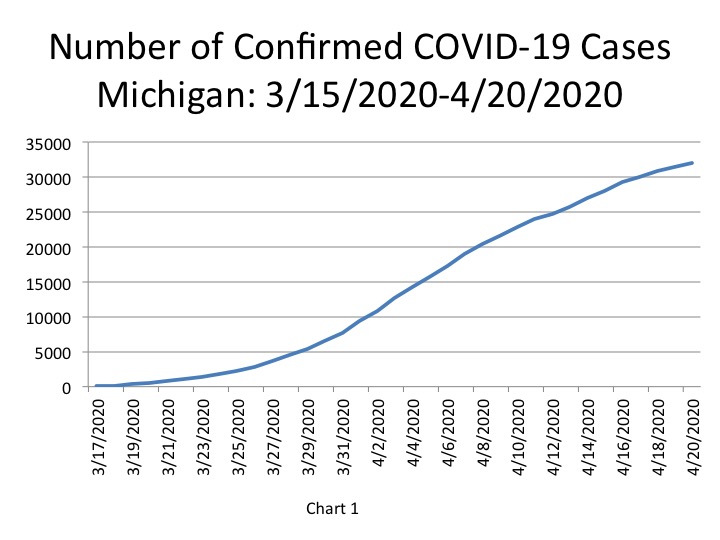
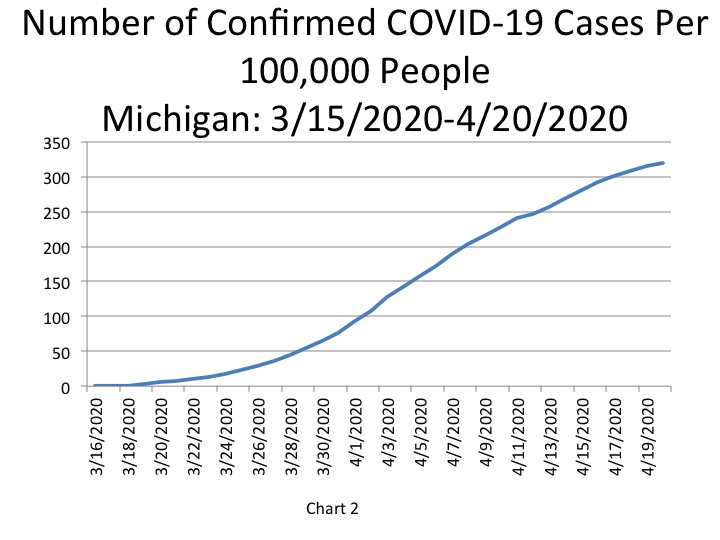
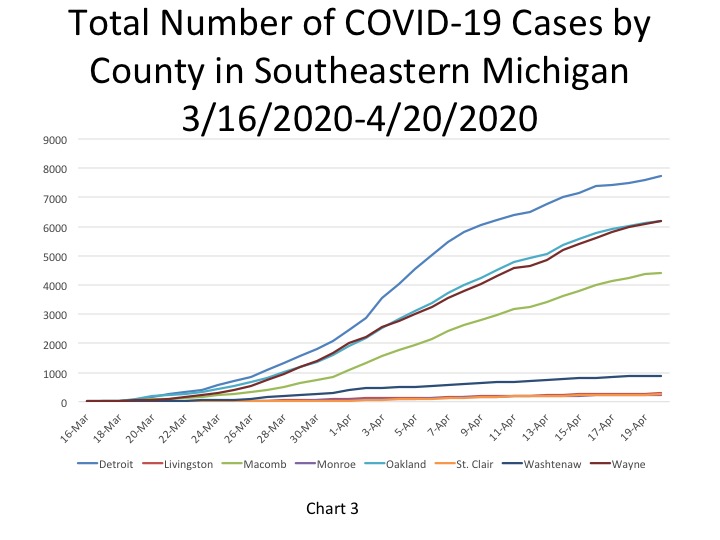
The City of Detroit had a total COVID case per capita rate of 1,150 per 100,000 people on April 20, an increase from a rate of 1,130 the day before (Chart 4). Oakland and Wayne counties (excluding Detroit) both had rates of 918 per 100,00 people. The rate for Wayne County increased more (increased by 13 points) than the Oakland County rate (increased by 10 points), further showing that the spread in Wayne County is increasing faster than in Oakland County. Macomb County had 658 COVID cases per 100,000 people.
Chart 5 shows that the City of Detroit was the only government entity focused on in this blog to post triple digit new positive COVID case numbers for April 20. According to the data, Detroit had 132 new COVID cases on April 20; Wayne County (excluding Detroit) had 88 new cases. In Oakland County the number of new cases on April 20 was 69, and in Macomb County it was 65. Monroe County posted the lowest number of new cases on April 20 at 3.
According to the data, Detroit had a rate of 20 new COVID cases per 100,000 people on April 20, reflective of a continued rate increase since April 17 (Chart 6). Livingston, St. Clair and Washtenaw counties were the only other government entities to post new daily COVID case rate increases from the day prior. In Macomb County, the daily COVID case rate was 7 per 100,000 people on April 20, a decrease from 12 new COVID cases per 100,000 people on April 19. Oakland County had a rate of 5 new COVID cases per 100,000 people on April 20, a decrease from a rate of 7 reported the day before (Chart 6). Also, on April 20 Wayne County reported a new COVID case rate of 8 per 100,000 people, a decrease from the rate of 11 reported on April 19.
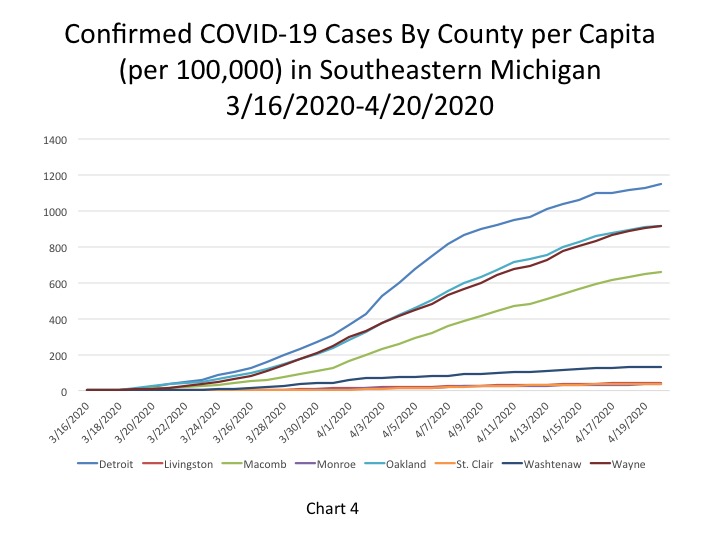
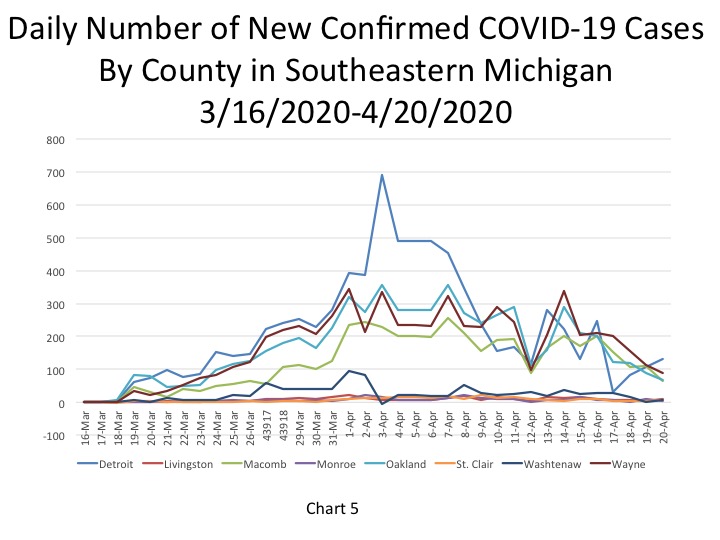
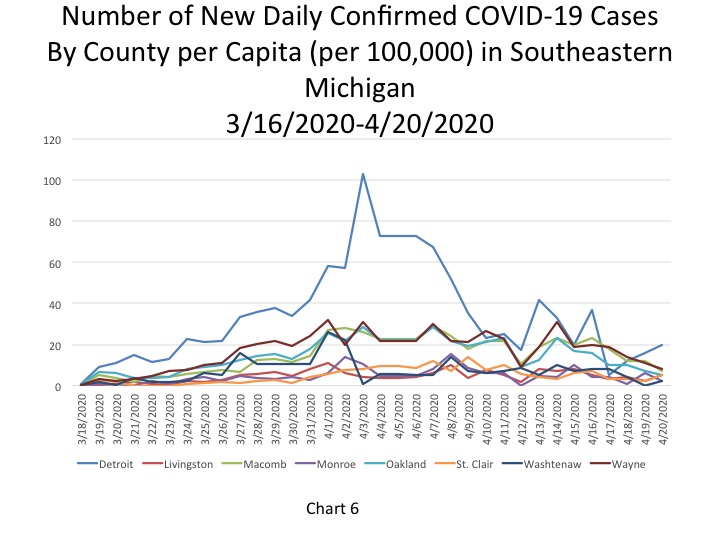
In addition to the raw data of confirmed cases, we also show the percent change in the number of cases reported day-to-day. On April 20 the percent change from April 19 was 1.8 percent, a small decrease from the day’s prior change of 2 percent.
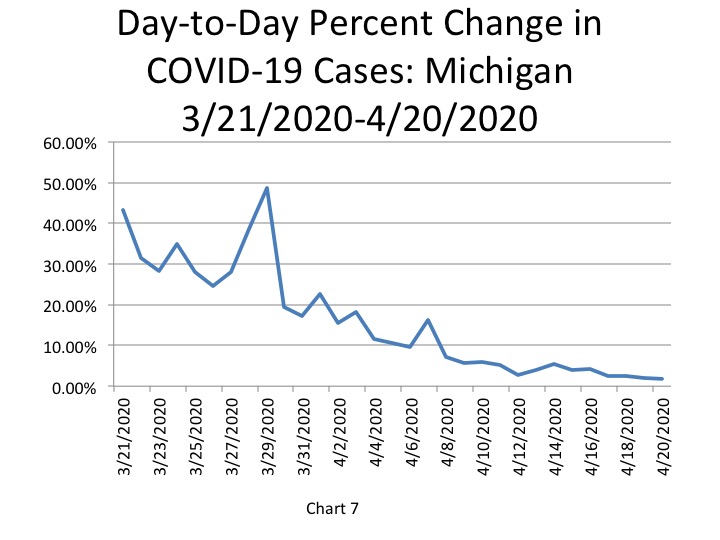
It was reported by the State of Michigan that on April 20 the total of COVID-19 deaths reached 2,468. This was a 3.2 percent change from April 19, which was a 0.4 percent decrease in the percent change in new daily deaths from the day prior (Chart 9). The 2,468 total deaths reported for April 20 was 77 deaths higher than what was reported on April 19 (Chart 10); this was 11 less deaths than the number of daily deaths reported on April 19. Also, the April 20 number was the lowest of new daily COVID deaths reported since April 5; 77 new deaths were reported that day too.
Of the total deaths reported, the number of COVID deaths in Detroit increased by 23 between April 20 and April 19. On April 20 the total COVID deaths across time for Detroit was 641 (Chart 11). Also on April 20, the Michigan Department of Health and Human Services also reported 507 total deaths in Wayne County (excluding Detroit), 479 in Oakland County and 403 in Macomb County (Chart 11).
On a per capita basis, per 100,000 people, Detroit also continues to have the highest number of deaths per 100,000 people at 95 on April 20; this is 20 points higher than Wayne County’s rate of 75 COVID deaths per 100,000 people (Chart 12). Oakland County had 71 COVID deaths per 100,000 people and Macomb County had 60.
As noted, Detroit had 23 new COVID deaths on April 20-this was the highest number of new daily deaths in the region, but was a decrease in the new number of daily deaths reported on April 19. Macomb County reported the second highest number of new deaths at 12 on April 20; Macomb County was the only government entity to post an increase in the number of new COVID deaths from April 19. For Oakland County, the number of new daily deaths was 8, a continued decrease since April 16, and in Wayne County there were 6 new deaths.
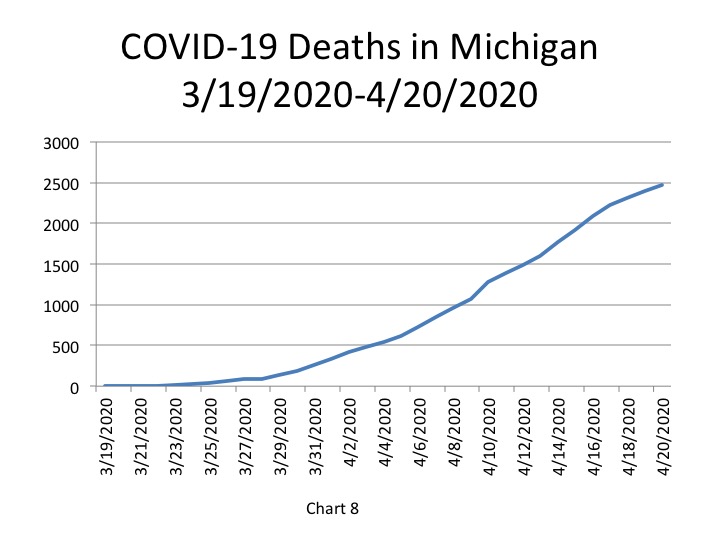
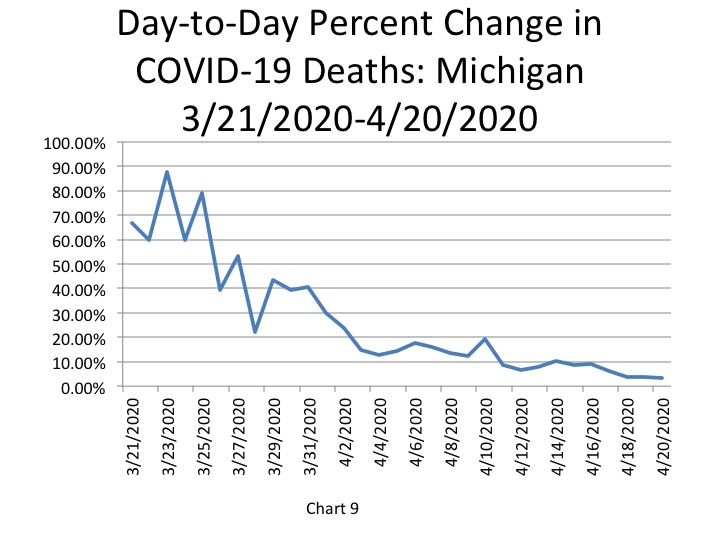
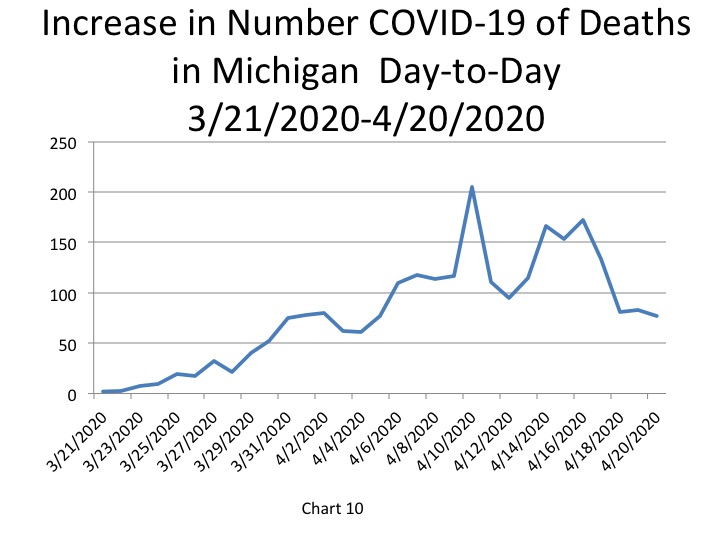
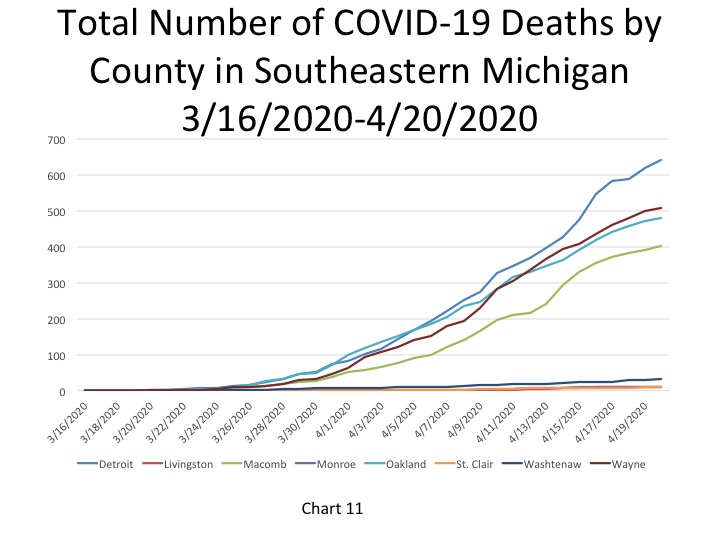
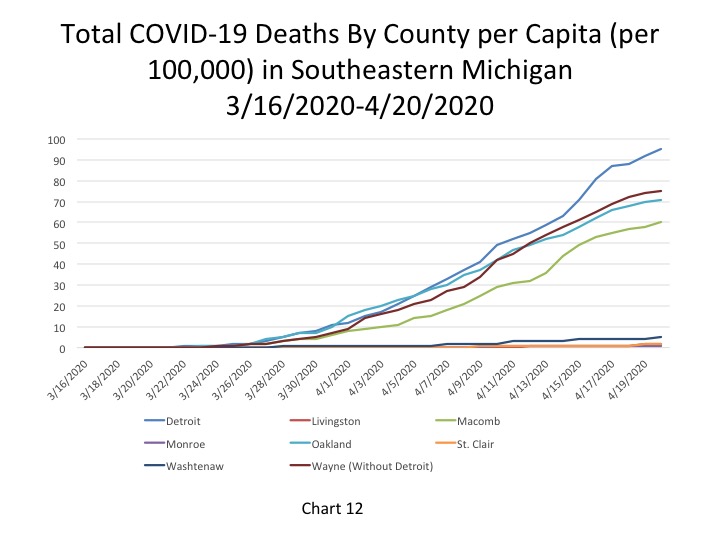
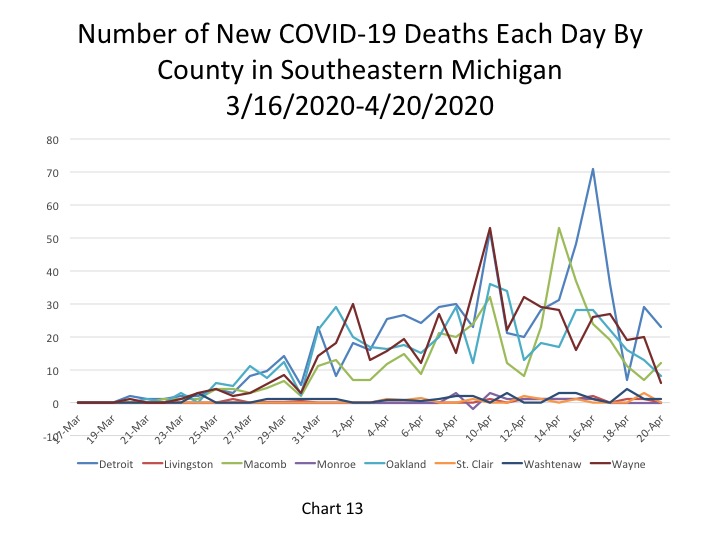
The final two charts below show the case death rates for the State of Michigan and for Detroit and the seven counties in Southeastern Michigan. To determine the rates we divided the reported deaths from each day by the number of total COVID cases each day.
On April 20 the COVID case fatality rate in Michigan was 7.7 percent; a slight increase from the 7.6 percent death rate reported the day before.
Of Detroit and the counties in the region, Macomb County continued have the highest case fatality rate at 9.1 percent on April 20. The fatality rate for Detroit was 8.3 percent on April 20, and in Wayne County (excluding Detroit) it was 8.2 percent. The fatality rate in Oakland County was 7.8 percent on April 20.
These fatality rates are very sensitive to the number of tests that are being completed across the region. In states or countries where far more testing is completed, death rates may be substantially lower. The failure of the CDC to complete and broadly distribute an early and accurate test has had huge consequences.
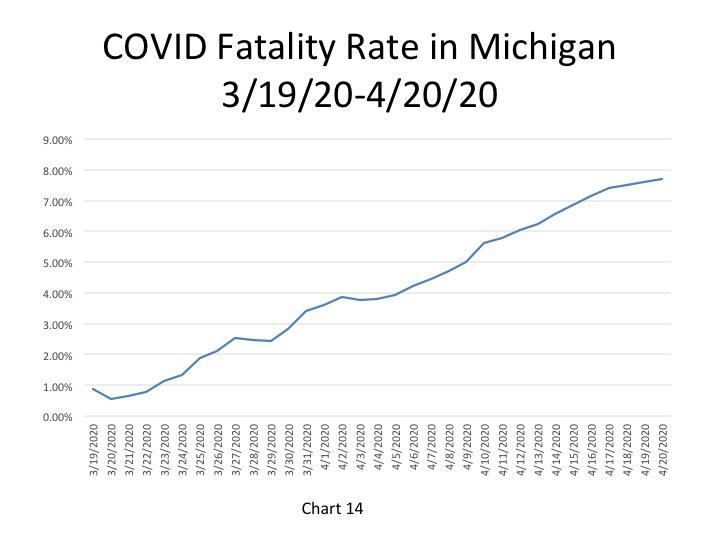
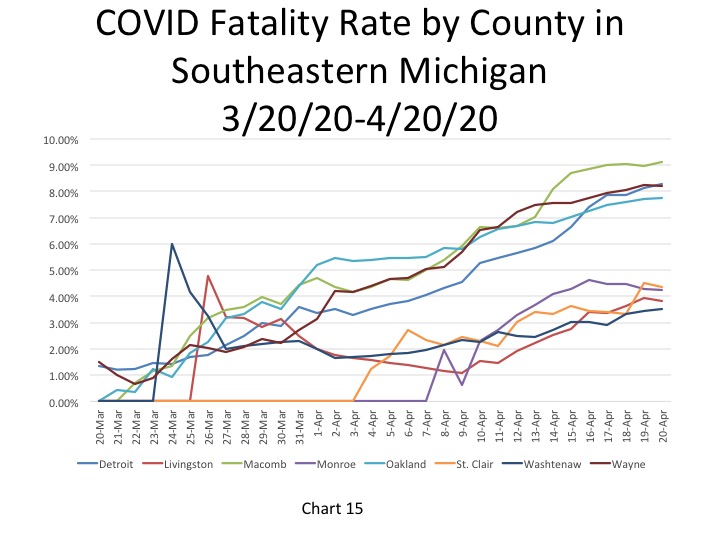
On April 20 Gov. Gretchen Whitmer announced that following the May 1 expiration of the Stay at Home Order life will not go back to normal immediately. Instead, businesses and life as we know it will resume slowly and in phases. Whitmer also said her plans, which are yet to be announced, will be data driven. And, as the data has shown thus far, the spread of the virus has certainly slowed but it is still very prevalent throughout Southeastern Michigan.